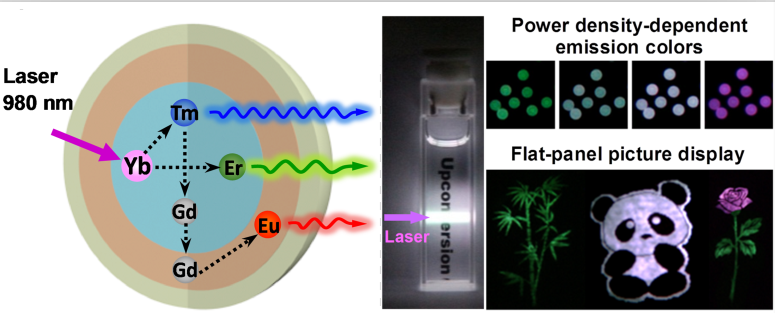
The color separation of white light has been widely adopted in modern display to obtain the pure red-green-blue (RGB) colors in pixels. The white backlight usually originates from a mixture of RGB materials in a strict proportion, which may be organic dyes, quantum dots or upconversion nanocrystals. However, these mixed emitters in one system have to face the problems of phase separation and energy transfer, which often lead to the inconsistent color brightness and short lifespan. However, it is a challenge to develop a single full-spectral material to revolutionize the current display via controlling the emission colors by a simple excitation source.
Recently, Prof. Zhongping Zhang’ s research group from Institute of Intelligent Machines (IIM), Chinese Academy of Sciences, has made significant progress in single white light upconversion nanostructure that can emit RGB colors to cover the full visible range. A paper entitled “White Light Emission from an Integrated Upconversion Nanostructure: Toward Multicolor Displays Modulated by Laser Power” was published inAngewandte Chemie International Edition.
In this paper, a single-structural, full-spectral upconversion nanostructure was prepared through optimizing the pathways of photon transitions from a set of selected lanthanide ions. Interestingly, researchers observed that the emission colors can be dynamically tuned by changing the excitation power density of a 980 nm laser. The emission colors exhibited a continuous evolution from green to cyan then white and red with power densities from 3 to 30 W cm-2. The RGB emitters exhibited different spectral sensitivities to excitation laser power density to allow a wide range of modulation of emission colors. The colorful flat-panel display was performed very simply by coating the nanocrystals onto a substrate when integrated with a highly-fine and power-tunable laser beam. Compared with the conventional color-fixed dyes or quantum dots, the color-tunable nanostructure as biological tags can significantly improve the reliability and convenience of biological tracking. Researchers believe that the new class of upconversion nanostructure will open a window of applications in display, biological imaging, chemical sensing and anti-counterfeiting.
This work was supported by National Basic Research Program of China, National Natural Science Foundation of China and Natural Science Foundation of Anhui Province.